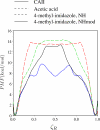"Proton holes" in long-range proton transfer reactions in solution and enzymes: A theoretical analysis
- PMID: 17165785
- PMCID: PMC2561195
- DOI: 10.1021/ja065451j
"Proton holes" in long-range proton transfer reactions in solution and enzymes: A theoretical analysis
Abstract
Proton transfers are fundamental to chemical processes in solution and biological systems. Often, the well-known Grotthuss mechanism is assumed where a series of sequential "proton hops" initiates from the donor and combines to produce the net transfer of a positive charge over a long distance. Although direct experimental evidence for the sequential proton hopping has been obtained recently, alternative mechanisms may be possible in complex molecular systems. To understand these events, all accessible protonation states of the mediating groups should be considered. This is exemplified by transfers through water where the individual water molecules can exist in three protonation states (water, hydronium, and hydroxide); as a result, an alternative to the Grotthuss mechanism for a proton transfer through water is to generate a hydroxide by first protonating the acceptor and then transfer the hydroxide toward the donor through water. The latter mechanism can be most generally described as the transfer of a "proton hole" from the acceptor to the donor where the "hole" characterizes the deprotonated state of any mediating molecule. This pathway is distinct and is rarely considered in the discussion of proton-transfer processes. Using a calibrated quantum mechanical/molecular mechanical (QM/MM) model and an effective sampling technique, we study proton transfers in two solution systems and in Carbonic Anhydrase II. Although the relative weight of the "proton hole" and Grotthuss mechanisms in a specific system is difficult to determine precisely using any computational approach, the current study establishes an energetics motivated framework that hinges on the donor/acceptor pKa values and electrostatics due to the environment to argue that the "proton hole" transfer is likely as important as the classical Grotthuss mechanism for proton transport in many complex molecular systems.
Figures





Similar articles
-
Proton transfer function of carbonic anhydrase: Insights from QM/MM simulations.Biochim Biophys Acta. 2010 Feb;1804(2):342-51. doi: 10.1016/j.bbapap.2009.07.026. Epub 2009 Aug 11. Biochim Biophys Acta. 2010. PMID: 19679196 Free PMC article. Review.
-
Proton transfer in carbonic anhydrase is controlled by electrostatics rather than the orientation of the acceptor.Biochemistry. 2008 Feb 26;47(8):2369-78. doi: 10.1021/bi701950j. Epub 2008 Feb 2. Biochemistry. 2008. PMID: 18247480
-
Speeding up proton transfer in a fast enzyme: kinetic and crystallographic studies on the effect of hydrophobic amino acid substitutions in the active site of human carbonic anhydrase II.Biochemistry. 2007 Mar 27;46(12):3803-13. doi: 10.1021/bi602620k. Epub 2007 Mar 2. Biochemistry. 2007. PMID: 17330962
-
Structural and kinetic characterization of active-site histidine as a proton shuttle in catalysis by human carbonic anhydrase II.Biochemistry. 2005 Feb 1;44(4):1097-105. doi: 10.1021/bi0480279. Biochemistry. 2005. PMID: 15667203
-
Role of protein motions on proton transfer pathways in human carbonic anhydrase II.Biochim Biophys Acta. 2010 Feb;1804(2):352-61. doi: 10.1016/j.bbapap.2009.09.004. Epub 2009 Sep 23. Biochim Biophys Acta. 2010. PMID: 19781668 Review.
Cited by
-
Crystallography and Its Impact on Carbonic Anhydrase Research.Int J Med Chem. 2018 Sep 13;2018:9419521. doi: 10.1155/2018/9419521. eCollection 2018. Int J Med Chem. 2018. PMID: 30302289 Free PMC article. Review.
-
An update of the chemiosmotic theory as suggested by possible proton currents inside the coupling membrane.Open Biol. 2019 Apr 26;9(4):180221. doi: 10.1098/rsob.180221. Open Biol. 2019. PMID: 30966998 Free PMC article. Review.
-
Proton transfer function of carbonic anhydrase: Insights from QM/MM simulations.Biochim Biophys Acta. 2010 Feb;1804(2):342-51. doi: 10.1016/j.bbapap.2009.07.026. Epub 2009 Aug 11. Biochim Biophys Acta. 2010. PMID: 19679196 Free PMC article. Review.
-
Active-site solvent replenishment observed during human carbonic anhydrase II catalysis.IUCrJ. 2018 Jan 1;5(Pt 1):93-102. doi: 10.1107/S2052252517017626. eCollection 2018 Jan 1. IUCrJ. 2018. PMID: 29354275 Free PMC article.
-
Role of hydrophilic residues in proton transfer during catalysis by human carbonic anhydrase II.Biochemistry. 2008 Nov 18;47(46):12028-36. doi: 10.1021/bi801473w. Epub 2008 Oct 23. Biochemistry. 2008. PMID: 18942852 Free PMC article.
References
Publication types
MeSH terms
Substances
Grants and funding
LinkOut - more resources
Full Text Sources

